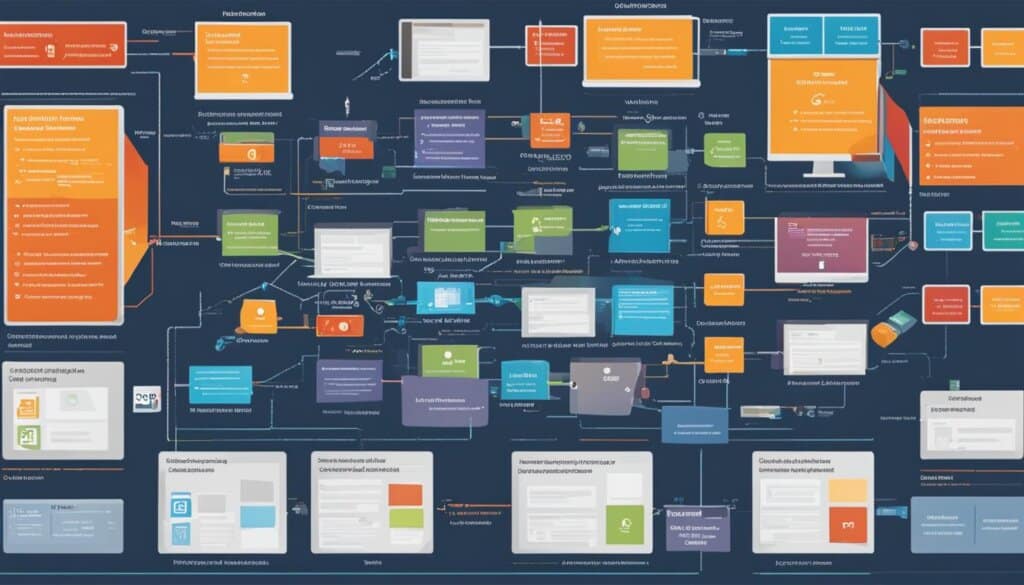Table of Contents
Single sign-on (SSO) is a session and user authentication service that allows users to use one set of login credentials to access multiple applications. It eliminates the need for users to remember separate passwords for each application and streamlines the authentication process. SSO is used by enterprises, small and midsize organizations, and individuals to simplify the management of multiple credentials.
How Does Single Sign-On Work?
Single sign-on (SSO) operates as a federated identity management arrangement, utilizing frameworks such as OAuth to facilitate the secure exchange of user account information with authorized third-party services. Through SSO, users can access these services without exposing their passwords. Here’s a step-by-step breakdown of how SSO works:
1. User Requests Access
When a user attempts to access an application that supports SSO, the service provider sends a request to the designated identity provider (IdP) for authentication. The IdP serves as the central source of user authentication and authorization.
2. Identity Provider Authentication
The identity provider verifies the user’s authentication by validating the provided credentials, which could be a username and password combination or other forms of authentication. Once the user is authenticated, the IdP generates an access token.
3. Generating the Access Token
The access token acts as proof of the user’s authentication and is securely transmitted to the service provider. This token serves as a unique identifier for the user and contains the necessary information to validate their authorization for accessing specific applications.
4. Establishing a Session
Upon receiving the access token, the service provider creates a session for the user, granting them access to the application. During this session, the user is authenticated for all the applications they have permission to use without the need for repeated password prompts.
Implementing SSO can enhance user experience by eliminating the hassle of multiple logins and reducing the risk of password-related issues.
This diagram illustrates the flow of information and authentication in a single sign-on system:
By employing federated identity management and secure protocols such as OAuth, SSO streamlines the authentication process, enhances user convenience, and ensures a centralized authentication approach across multiple applications.
Types of SSO Configurations
Single sign-on (SSO) can be implemented using various configurations, each offering its own benefits and features. Let’s explore some of the common types of SSO configurations:
Kerberos
Kerberos is a protocol used by some SSO services to simplify the authentication process. When a user provides their credentials, a ticket-granting ticket is issued, granting access to other applications without the need for reentering credentials. This improves user experience and streamlines the login process.
Security Assertion Markup Language (SAML)
SAML is another widely used protocol in SSO. It enables the secure exchange of user authentication and authorization data across different domains. With SAML, users can authenticate once and gain access to multiple applications without the need for repeated login prompts.
Smart Card-Based SSO
Smart card-based SSO utilizes smart cards that store sign-in credentials. Users can simply insert the smart card for the initial login and subsequently access applications without reentering usernames or passwords. This approach enhances security and eliminates the hassle of password management.
These different SSO configurations offer organizations flexibility in choosing the most suitable method based on their security requirements and user needs.

SSO Security Risks
While SSO provides convenience to users, it also presents security risks to enterprise systems. If an attacker gains control over a user’s SSO credentials, they can access all applications that the user has rights to, potentially causing significant damage.
To mitigate these risks, organizations should implement identity governance measures and consider using two-factor authentication (2FA) or multifactor authentication alongside SSO to enhance security.
“Implementing identity governance measures is essential for maintaining enterprise security. Organizations should establish strict policies and procedures to govern SSO access and regularly audit user accounts to detect any unauthorized access or suspicious activity. This can help prevent attackers from leveraging compromised SSO credentials to gain unauthorized access to critical systems and sensitive information.”
-
Two-factor authentication (2FA): Implementing 2FA alongside SSO adds an extra layer of security. With 2FA, users need to provide two different types of authentication factors – typically something they know (such as a password) and something they have (such as a hardware token or mobile device). This makes it more difficult for attackers to gain unauthorized access even if they possess the user’s SSO credentials.
-
Multifactor authentication: Multifactor authentication goes beyond 2FA by requiring additional authentication factors, such as something the user is (biometrics) or something the user does (behavioral biometrics). By combining multiple factors, organizations can further strengthen their security posture and reduce the risk of unauthorized access.
By implementing these additional security measures, organizations can significantly enhance their enterprise security and protect against potential damage resulting from compromised SSO credentials.
| Security Risk | Potential Impact |
|---|---|
| Attacker gains control of SSO credentials | Potential unauthorized access to all applications and systems the user has rights to; potential data breaches, loss of sensitive information, and financial losses |
| Lack of identity governance measures | Potential for unauthorized access and misuse of SSO credentials; compromised user accounts; difficulty in detecting and mitigating security incidents |
| No additional authentication factors (2FA or multifactor authentication) | Increased risk of successful credential attacks and unauthorized access; potential for account takeovers and data breaches |
Social SSO
Popular social media platforms such as Google, LinkedIn, Apple, Twitter, and Facebook offer social SSO services to users. This feature allows individuals to log in to third-party applications using their social media authentication credentials. By leveraging their existing Google, LinkedIn, Apple, Twitter, or Facebook accounts, users can seamlessly access multiple applications without the need for separate login credentials.
While social SSO offers convenience and simplifies the login process, it also introduces security risks. Using social media authentication creates a single point of failure, which hackers can exploit to gain unauthorized access to multiple applications associated with the same credentials. This poses a significant concern for users and organizations alike.
Security professionals advise caution when using social SSO services to mitigate potential security risks. Users should exercise vigilance and take necessary precautions to protect their accounts from unauthorized access. Implementing additional security measures such as strong passwords, two-factor authentication, and regular monitoring of account activity are essential steps to safeguard personal information.
“Social SSO offers convenience, but users must be cautious of the security risks associated with this authentication method.”
Enterprise SSO
Enterprise single sign-on (eSSO) systems are password management solutions that simplify the login process for users accessing target applications. These solutions consist of client and server components and do not require any modifications to the target applications. With eSSO, users only need to authenticate their credentials once, typically a username and password, and they can then access multiple applications without the need to reenter their credentials.
Implementing an eSSO system can bring significant benefits to enterprises by enhancing productivity and reducing password-related challenges. By seamlessly logging users onto target applications, eSSO eliminates the hassle of remembering and managing multiple passwords, improving overall user experience. Additionally, eSSO can lead to time savings and increased efficiency by streamlining the login process and reducing the need for manual authentication.
In an eSSO system, password managers play a crucial role in securely storing and replaying user credentials. These managers store the encrypted usernames and passwords, allowing users to access multiple applications with a single click or keystroke. Password managers help prevent the frustration of forgotten passwords and provide a convenient and efficient solution for users navigating through various target applications.
Let’s take a look at how the client and server components work together in an eSSO system:
Client Component
The client component of an eSSO system is installed on the user’s device (e.g., computer, smartphone) and works in the background to capture login credentials when the user enters them on the login page. The captured credentials are securely stored by the password manager for future use, eliminating the need to reenter them each time the user accesses the target applications.
Server Component
The server component of an eSSO system operates on the backend and communicates with the target applications that are part of the SSO ecosystem. It manages user authentication and handles the replaying of saved credentials to log users onto their desired applications automatically.
By combining both the client and server components, the eSSO system creates a seamless and convenient experience for users, ensuring quick and secure access to a wide range of target applications without hassle or interruption.
The image above visually represents the concept of enterprise single sign-on (eSSO) systems, highlighting the integration between the client and server components and the simplified login experience it provides for users accessing target applications.
Advantages of SSO
Implementing Single Sign-On (SSO) offers several benefits that bring convenience and enhanced security to users and organizations alike. By leveraging SSO, businesses can optimize their processes and mitigate various password-related challenges. Let’s explore the advantages of SSO in more detail:
1. Fewer Passwords to Remember
With SSO, users only need to remember and manage one set of credentials, reducing the number of passwords they need to keep track of. This alleviates the frustration of having multiple passwords for different applications and simplifies the login experience.
2. Streamlined Sign-On Process
Implementing SSO streamlines the sign-on process by eliminating the need for users to reenter passwords for each application. Upon authentication, users gain access to multiple applications seamlessly, saving time and effort.
3. Reduced Phishing Risks
SSO helps reduce the risk of falling victim to phishing attacks. Phishing attempts often trick users into revealing their passwords, but with SSO, users authenticate themselves once, and subsequently, no further passwords are required during the same session. This decreases the likelihood of exposing sensitive information to malicious actors.
4. Fewer Password-Related Complaints
Implementing SSO can lead to a reduction in password-related complaints and issues reported to the IT help desk. Since users have a streamlined login experience and fewer passwords to manage, the reliance on IT support for forgotten passwords or login difficulties decreases significantly.
| Advantages | Description |
|---|---|
| Fewer Passwords to Remember | Users only need to manage one set of credentials. |
| Streamlined Sign-On Process | Eliminates the need to reenter passwords for each application. |
| Reduced Phishing Risks | Decreases the risk of falling victim to phishing attacks. |
| Fewer Password-Related Complaints | Reduces the number of password-related issues reported to the IT help desk. |
Experience the benefits of SSO and revolutionize your authentication processes. Implementing SSO ensures a secure, efficient, and user-friendly login experience for your organization.
SSO Vendors
Various vendors offer a wide range of SSO products, services, and features to meet the authentication and access management needs of organizations. Some notable SSO vendors in the market include Rippling, Avatier Identity Anywhere, OneLogin, and Okta. These vendors provide comprehensive solutions to simplify the implementation and management of SSO.
Rippling is a popular SSO vendor that enables users to conveniently sign in to cloud applications from multiple devices. With its user-friendly interface and robust security features, Rippling ensures a seamless and secure SSO experience.
Avatier Identity Anywhere offers SSO specifically designed for Docker container-based platforms. This vendor provides advanced authentication and access management capabilities, ensuring secure and efficient operations in containerized environments.
OneLogin by One Identity is a cloud-based identity and access management platform that supports SSO. With its extensive range of features and integrations, OneLogin simplifies user authentication and provides enhanced security for organizations.
Okta is a renowned tool primarily used by enterprises for its SSO functionality. Okta’s comprehensive suite of services and features empowers organizations to manage user access across multiple applications and platforms efficiently.
These SSO vendors offer solutions that cater to the diverse needs of organizations looking to implement and manage SSO effectively. Whether it’s for cloud applications, Docker container-based platforms, or enterprise-level requirements, these vendors provide secure, streamlined, and user-friendly SSO solutions.
FAQ
What is Single Sign-On (SSO)?
Single sign-on (SSO) is a session and user authentication service that allows users to use one set of login credentials to access multiple applications. It eliminates the need for users to remember separate passwords for each application and streamlines the authentication process. SSO is used by enterprises, small and midsize organizations, and individuals to simplify the management of multiple credentials.
How does Single Sign-On work?
Single sign-on works as a federated identity management arrangement. It uses frameworks like OAuth to enable the use of a user’s account information by third-party services without exposing the user’s password. When a user attempts to access an application, the service provider sends a request to the identity provider for authentication. The identity provider verifies the authentication and logs the user in, creating a session. In this session, the user is authenticated for all the applications they have access to, eliminating the need for password prompts during the same session.
What are the types of SSO configurations?
SSO can be implemented using different configurations. Some SSO services use protocols like Kerberos, where a ticket-granting ticket is issued once user credentials are provided, allowing access to other applications without reentering credentials. Another protocol commonly used is Security Assertion Markup Language (SAML), which facilitates the exchange of user authentication and authorization data across secure domains. Additionally, there is smart card-based SSO, where users use a card holding sign-in credentials for the first login and do not need to reenter usernames or passwords. Smart cards can store certificates or passwords for authentication purposes.
What are the security risks associated with SSO?
While SSO provides convenience to users, it also presents security risks to enterprise systems. If an attacker gains control over a user’s SSO credentials, they can access all applications that the user has rights to, potentially causing significant damage. To mitigate these risks, organizations should implement identity governance measures and consider using two-factor authentication (2FA) or multifactor authentication alongside SSO to enhance security.
What is Social SSO?
Social SSO refers to the use of social media authentication credentials to log in to third-party applications. Popular social media platforms like Google, LinkedIn, Apple, Twitter, and Facebook offer social SSO services. While social SSO is convenient, it also introduces security risks by creating a single point of failure that can be exploited by attackers. Security professionals often advise users to exercise caution when using social SSO services to prevent unauthorized access to multiple applications associated with the same credentials.
What is Enterprise SSO?
Enterprise single sign-on (eSSO) systems are password management solutions that log users on to target applications by replaying their credentials. These solutions consist of client and server components and do not require modifications to the target applications. The credentials used for eSSO are typically a username and password, and once authenticated, users can access multiple applications without having to reenter their credentials.
What are the advantages of implementing SSO?
There are several advantages to implementing SSO. Users only need to remember and manage one set of credentials, reducing the number of passwords they need to keep track of. The sign-on process is streamlined, eliminating the need to reenter passwords for each application. SSO also reduces the risk of falling victim to phishing attacks. Additionally, implementing SSO can lead to fewer password-related complaints or issues reported to IT help desks.
What are some popular SSO vendors?
Various vendors offer SSO products, services, and features. Some notable SSO vendors include Rippling, which enables users to sign in to cloud applications from multiple devices, Avatier Identity Anywhere, which offers SSO for Docker container-based platforms, OneLogin by One Identity, a cloud-based identity and access management platform that supports SSO, and Okta, a tool with SSO functionality primarily used by enterprises. These vendors provide solutions to help organizations implement and manage SSO effectively.












